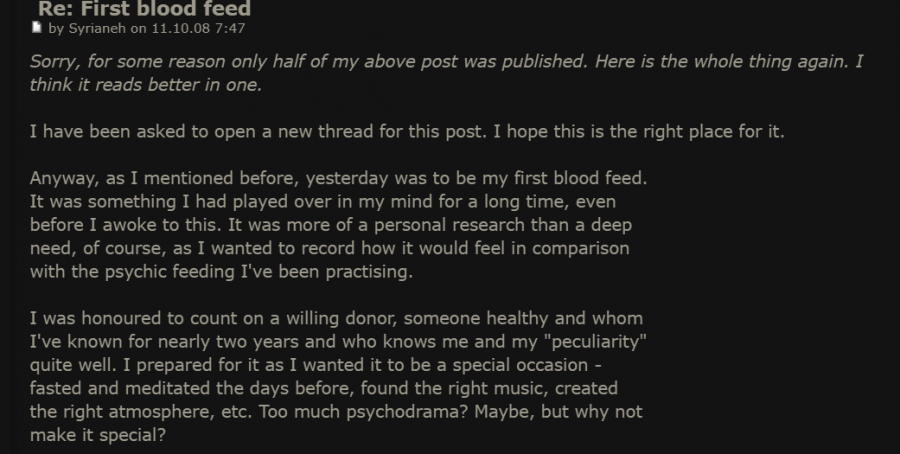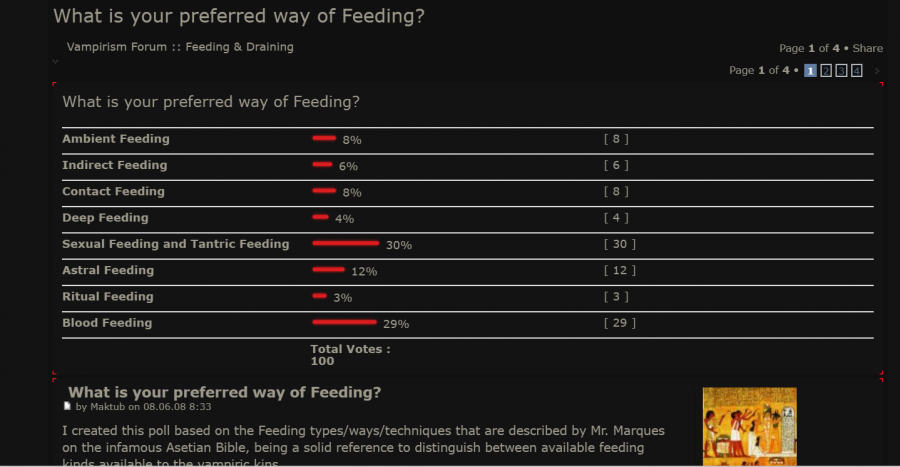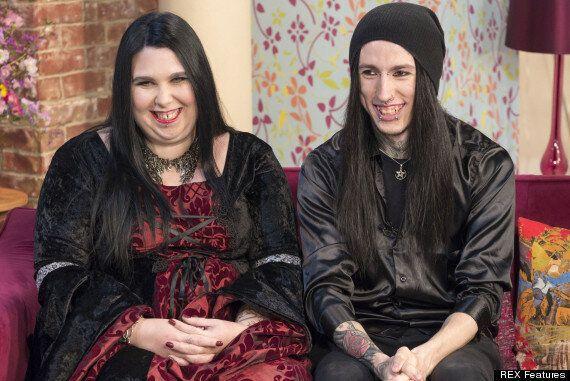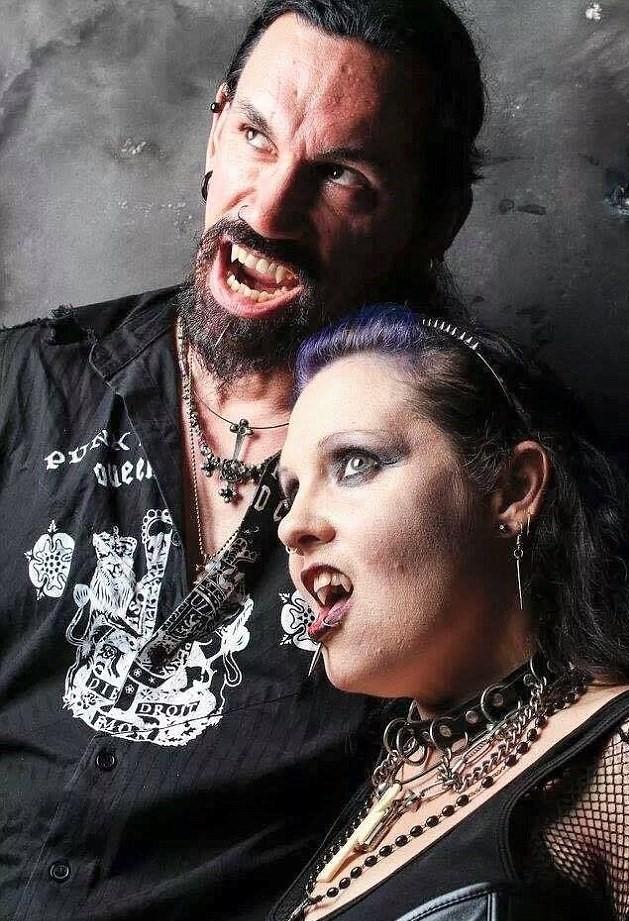
Contemporary vampires: Should we be afraid of the dark?
Vampires are popular fictional creatures appearing in myths, works of literature, films, and the fairytales we used to hear as children. But what of vampires in the real world?
Beyond the romantic sagas of Twilight or The Vampire Diaries, there are people around the world belonging to the social group of "real vampires", who, as their name suggests, believe that they are actual, real vampires. The vampire community is not particularly fond of the idea of being found; they prefer to keep their identity private. However, they communicate with each other in forums, where they discuss their desire for blood, different ways of feeding, and how to find donors who will support their needs.
In this article, I will go through the history of the real vampire community in order to analyze real vampires as a social group. What kind of indexes do members have that identify them as vampires, and why is their behavior marked as deviant? Could these "real vampires" be considered a threat for society?
The history of the real vampire community
The real vampire community consists of members who tend to believe that they are vampires and identify as such. This social group belongs to the subculture of Otherkin, a term that refers to a subculture sharing “a set of perspectives and understandings about what the world is like and how to deal with it, and a set of routine activities based on those perspectives” (Becker, 1963), in which people socially and spiritually identify as not entirely humans. They largely identify as mythical creatures and many of them believe in the existence of a parallel universe; in fact, their belief in the existence of supernatural, non-human beings, is grounded in that idea (Wikipedia, 2019). For example, people belonging to such groups can consider themselves elves, dragons, fairies, and even aliens. But, despite the fact that the real vampire community is part of the Otherkin, it is culturally and historically a distinct movement of its own.
According to ethnographic research conducted by Josh Edgar Browning, the term "real vampire community" is used to describe "modern vampires" or "real vampires", and it is used for all of the three types of vampires in the group.
The Internet has led to the disappearance of geographic borders for real vampires.
The first vampire type is that of "sanguinarians", who consume human and/or animal blood; the second kind is that of "psychic" vampires, who absorb psychic energy; and the last type is "hybrids", a group of vampires who practice both ways of “feeding”.
According to Browing, the term "real vampires" did not exist until the late 1990s, and back then it referred mostly to a network of online message boards, chat rooms, forums, and e-mails. In the last decade, the Internet is the tool to which the community owes much of its prosperity. The Internet has led to the disappearance of geographic borders for real vampires and it has made their correspondence much easier.
They might not turn into bats or claim that they live forever, but this community of vampires is in fact real in the sense that it is comprised of living people, leading what we can call an everyday life, who adopt the figure of a vampire for self-identificatory purposes.
Vampire indexes
Indexicality is a notion that describes the fact that "every utterance tells something about the person who utters it and about the kind of person we encounter" (Blommaert, 2005). Every social group possesses certain indexes, which identify the group members as such. The first index that points out the community of vampires is the desire for blood, which they allegedly need because of “energy leaks” that might make them feel sick. In order to prevent energy imbalances and stay healthy, they need other people’s blood or "energy". Kinesia (a member of the real vampire community) says: “Once I went four months without feeding on blood and ended up in the emergency room with a low heart rate”.
Figure 1. A vampirismforum.com user discusses blood-drinking.
Real vampires do not satisfy their desire in the way that probably many of us imagine judging from what movies and literature have taught us. As we can see in Figure 1 above, they consume blood only from donors, who are people they know and trust with their identity. Also, the donors give their blood with consent (“willing donor”). But how do real vampires describe the taste and the feeling of consuming blood once they get to do it?
As 38-year-old Georgina Condon says, blood has a metallic taste. Researcher Josh Browning, who has interviewed a few members of the community, also finds them generally stating that the taste of blood is metallic or “coppery”, which could be due to the donor’s physiology or lack of hydration. Blood-drinking and physical vampires feel more energized than they would if they sustained themselves on regular food alone.
However, not all vampires feed on blood. Some of the physic vampires we mentioned above rely on "tantric feeding" through sexual encounters, while others yet practice astral feeding or feed through emotion.

Figure 2. Feeding poll on vampirismforum.com.
My own research in an open forum dedicated to the vampire community also shows that vampires use several ways of feeding. Figure 2 shows a poll created on www.vampirismforum.com, about vampires' favorite type of feeding. Despite the fact that most vampires engage in more than one type, they rarely use all of the feeding types listed in Figure 2. They tend to stick to 2 or 3 types, usually the ones that appeal most to their nature, ethics, personal preferences, and availability (see Figure 3).

Figure 3. Preferred ways of feeding for a user on vampirismforum.com’
Interestingly, however, some of the members of the forum tend to believe that there are no absolutely divided types of feeding. As forum member Maktub states, “psychic vampires can draw energy from blood, the same as sanguinarians can draw energy alone without the blood”.

Figure 4. A picture of vampire couple Pyretta Blaze and Andy Filth.
In Figure 4, we can see Pyretta Blaze and Andy Filth, a married vampire couple, who are active and fully engaged members of the vampire community. As we can observe, they are dressed in dark clothes and wear black makeup, which are typical features for the gothic style. Aside from the blood-drinking and energy feeding, a significant number of the members of the real vampire community dress in gothic style, which suits their self description as "dark creatures of the night".
Another index of the group is the places where they meet. As Katherine Ramsland, professor of Forensic Psychology at DeSales University and author of The Science of Vampires", states, “people who identify as vampires often meet at underground clubs, but they're all over the place”.
Some vampires also display their identity by wearing prosthetic fangs (see Figure 5), a practice that for most of them is purely aesthetic. Fangs are part of their culture, especially in New Orleans, where they contribute to intercommunal identification (Browning, 2015). However, those who dress in that specific gothic style and wear fangs begin to do so long after they have embraced their vampire self. These indexes are probably the reason why vampires are often referred to as a “deviant culture”.

Figure 5. Georgina Condon and her partner Zameal’s prosthetic fangs.
The real vampire community as outsiders
According to Becker (1963), social groups establish and follow rules which dictate what kind of behaviors are right or wrong; those who break rules established by certain social groups may not longer be trusted to be members, and are thereby seen as outsiders. From Becker's theoretical standpoint, the social group of real vampires is labeled as a deviant group of "outsiders" because its members do not follow the conventional rules of the society. However, becoming an outsider is not only an individual act; it is a result of many actors’ interactions. As Becker stated in his work Outsiders, deviance is created by society making rules and applying these rules to particular people and then labeling them as outsiders. The deviant one is the one to whom the label has successfully been applied.
As a social group, real vampires, instead of rejecting the label of misfits, embrace their difference in order to achieve a sense of self-empowerment.
As Katherine Ramsland has said: "Some people are misfits. Some people are just creative people who don't feel they fit into normal society, so some people find the vampire a very empowering figure, and they want to identify with that." Thus, as a social group, real vampires, instead of rejecting the label of misfits, embrace their difference in order to achieve a sense of self-empowerment, because to become deviant is a social and historical process and an act of power. Josh Browning also states that “through manifesting its own deviance by means of defiance for its own sake, [the group] achieves as it was a degree of self-empowerment”. The study of vampires and their community amounts in a certain sense to the study of deviance, which renders it all the more interesting a subject for academic research.
Authenticity discourse
The social group of real vampires has become a subject of research in many universities and academic institutions around the globe. Major TV channels like National Geographic The Discovery Channel and BBC have also produced documentary films and series dedicated to them. Therefore, the subculture has became popular in mainstream media and society by catching the interest of more and more people, who eventually started to present themselves as vampires, because they find the group to be interesting or exotic. As more people have started adopting the identity of vampire, a discourse has emerged on what makes an "authentic" vampire, in a process common to what Maly and Varis (2015) observe in their study on hipsters.
Newcomers to the vampire world adopt the indexes of the group in order to become part of it – the dress style, beliefs, feelings, and methods of feeding. However, identity indexes differ from one context to another, and some of them are recognized on a global scale, while others have a more local scope (specific to a country and a city). For example, the gothic style of dressing and the fake fangs are common indexes for the vampires in the USA and parts of Europe because they have existed as a community for a longer period of time, while the vampire community in Russia is still quite new and still developing its features, which makes it not quite like the others. As Russian vampire) states: “our local community is different” (Figure 6). However, a global index for all vampires is theirways of feeding. They are always the same, no matter where you are in the world.

Figure 6. A Russian vampire speaks about their local vampire community on thegraveyardpress.wordpress.com.
Indexes also produce stratification by creating processes of exclusion and inequality. Inclusion in the group requires the "right" emblematic features, but these are ordered in the sense that some of them may not have the same effect on a global level.
Figure 7: A "fake" vampire gets called out on www.vampirewebsite.net.
Visible indexes themselves are not enough, therefore an "authentic" vampire identity needs to be accompanied by a set of features that distinguish "real" vampires from fake ones. The look of the social group could be achieved easily, but that would not make someone a real vampire, because they would need to also have the same inner stance about feeling that they are vampires as other members of the community. Thus, the way someone feels also functions as an instrument for inclusion in and exclusion from the group (see Figure 7).
From this data, we can conclude that the social group of real vampires is translocal and polycentric, because it is distributed geographically around the globe, from Russia to England and the United States, and its norms, such as the characteristics one needs to bear to be part of the group, vary locally.
Final thoughts
Despite vampire subculture being seen as especially deviant from mainstream society, members of the social group range beyond those who drink blood and are open about being vampires. Some have an everyday job and live a normal life during the day, having their vampire identity come out only at night. Thus, a number of vampires possess two identities and live in two different worlds.
Much research on vampires aims at finding the reasons why people identify as such. Many members of the group claim that they are born this way and that this is their real nature. However, according to Katherine Ramsland, some people experiment with the identity because they do not find their place in mainstream society.
In fact, the real vampire community does not go around advertising themselves because they fear being discriminated against by people who do not understand their culture and beliefs, or even being labeled as mentally ill. Many hide their vampire identity from everyone, including their families, for all their life. Vampirism is not considered a religion, but it is more of a spiritual or philosophical path. Real vampires can and do take this path, existing among mainstream society and their community at the same time.
References
Becker, H. (1963), Outsiders. The Free Press.
Browning, J. (2015), “The real vampires on New Orleans and Buffalo: a research note towards comparative ethnography”
Browning, J. (2015), “Real-Life Vampires Exist, and Researchers Are Studying Them”. Georgia Institute of Technology
India Today (2015), “Vampires are real! Many of them live in New Orleans”
Maly, I. & Varis, P. (2015), The 21st century hipster: on micro-population in times of superdiversity,.Tilburg Papers in Culture Studies.
Martizen-Ramundo, D.&Martelli, J. (2009), “Coming Out of the Coffin: Vampires Among Us”
Wikipedia, 2019, “Otherkin”
Wikipedia, 2019, “Vampire lifestyle”
https://www.itv.com/thismorning/hot-topics/real-life-vampires-drink-blood
https://www.india.com/buzz/38-year-old-vampire-drinks-her-boyfriends-blo...
https://thegraveyardpress.wordpress.com/2012/02/15/a-vampire-from-russia/
https://www.youtube.com/watch?v=uwo-Mz9DA7c&t=105s
http://www.vampirismforum.com/
